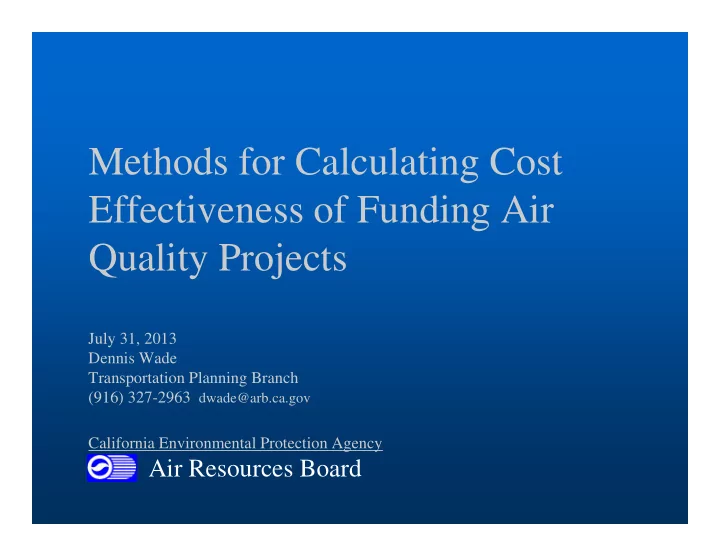

Methods for Calculating Cost Effectiveness of Funding Air Quality Projects July 31, 2013 Dennis Wade Transportation Planning Branch (916) 327-2963 dwade@arb.ca.gov California Environmental Protection Agency Air Resources Board
Overview of the Congestion Mitigation and Air Quality Improvement Program (CMAQ)
CMAQ Funding CMAQ provides a flexible funding source to State and local governments for transportation projects and programs to help meet the requirements of the Clean Air Act. CMAQ funds are federal Highway Trust Fund dollars apportioned to the States.
CMAQ Funding Process Highway Trust Fund dollars are apportioned by US DOT to the � State (Caltrans) by formula in statute. � Caltrans Programming apportions the State share (by formula in State law) to MPOs in areas that do not attain or are maintenance for federal air quality standards. � MPOs/RTPAs call for projects; projects are evaluated against several criteria including cost effectiveness MPOs/RTPAs report statistics including cost effectiveness on funded projects to Caltrans, then to FHWA. � Cost effectiveness is the Funding divided by the emissions reduced.
Project Eligibility and the Role of Cost Effectiveness in CMAQ From FHWA: Eligible activities Funds may be used for transportation projects likely to contribute to the attainment or maintenance of a national ambient air quality standard, with a high level of effectiveness in reducing air pollution, and be included in the Metropolitan Planning Organization's (MPO's) current transportation plan and transportation improvement program (TIP) or the current state transportation improvement program (STIP) in areas without an MPO. (emphasis added) FHWA is required to maintain a database of cost effectiveness for use by MPOs in project selection, and periodically evaluate funded projects for emissions reduced and cost effectiveness.
Methods and Emission Factors
Methods - Background Original methods document was developed by ARB and Caltrans and probably issued in late 90’s. Methods have remained essentially unchanged. ARB creates database tool. Since 2005, ARB has issued revisions to emission factors as our models have changed. Latest revision in May 2013 replaced PM10 rates with PM2.5. ARB posts PM conversion factors in July 2013.
Methods � Each method contains the following information: – A list of the information needed to evaluate cost-effectiveness. – “Defaults” that may be used when data are not available. – Formulas to calculate vehicle emission reductions for four major pollutants: Reactive organic gases (ROG) Nitrogen oxides (NOx) Particulate Matter (PM2.5) CO is given for most gasoline engines/vehicles CO and ROG are not usually relevant for diesel engines PM10 can be estimated from size fraction table.
Methods (cont’d) � Each method contains : – Formula for calculating cost effectiveness – Sample calculations. � Methods are not to be used to calculate mobile source emission reduction credits that are traded or sold .
Examples for Today - Signal synchronization/Interconnect - CNG Sanitation Truck Purchase - Bike Lanes - Alternative fueling station (Discussion) - Shoulder Paving (Discussion)
Signal coordination/Interconnect
Signal coordination/Interconnect � How emissions are reduced: – Increasing average traffic speeds to up to 36 mph. (NOx emissions start increasing when average speeds are over 36 mph.) � Travel growth degrades project performance over time � � ����������������������������������� ���������������������������������������� �����������������������������������
Signal coordination/Interconnect � Need to know: � ��������������� � ��������������������������������� � ������������ � ������������������������������������������������� ���� �������������! � "�����������������#��������������������������� ������� � $��������������������������������������
Signal coordination/Interconnect Example � Need to know: � ��������%�&'()***�+�,-��&.)***������������ � ��������"���%��.������� �������! � /����������������������%��0.*� 1������)����������� #�������!� � +�����������������������%��23)20. � "�����������������#����������%�*�'2������ � $��������������������������������������% • Before Project: 27.6 mph • After Project: 32.7 mph
Signal coordination/Interconnect Emission Factors � Emission factors dependent on speed. Use Table 4, 1-5 year project life. Interpolate or round up; just do the same for all the rates in your analysis. Rates are in grams per mile. – Before: 27.6 mph 4/5�*�2* • 6 +/�0�.'� 6 �/7�*�'' 6 ��0�.�*�**8 – After: 32.7 mph 6 4/5�*�*9 6 +/�0�'' 6 �/7�*�'0 6 ��0�.�*�**'
Signal coordination/Interconnect Formula – Emissions Reduced Project VMT = � • Operating days * Project Length * Trips • 250 * 0.31 * 18,125 � = 1,404,687.5 miles Emissions Reduced (lbs) = � – 0.5 * [(VMT)*(Before Speed Factor - After Speed Factor)]/454 – Calculate each pollutant separately Reductions in pounds per year: � – ROG – 30.9 – CO – 618.8 – NOx – 30.9 – PM2.5 – 3.1
Signal coordination/Interconnect Cost Effectiveness Calculation � Cost effectiveness in dollars per pound = – Capital Recovery Factor (CRF)*Funding / – Sum of ROG+CO/7+NOx+PM2.5 reduced. � CRF from Table on page 2 = 0.22 (5 yr project life) Cost effectiveness = $50.20 per pound. � � What about CO/7? � Convert to Kg if needed. Kg = lbs/2.2 � Questions?
Cleaner Emissions Vehicle CNG Sanitation Truck
Cleaner Vehicle Purchase :�#����������������������%�� ;������������������������������������������������#���� ����#)�������������������������������������������� �����������#��������#)������������������������ �����������#% ��������������� ,����������������������������� <��! ;��������������������������������������������� ��������������
Cleaner Vehicle Purchase The Search for Information ���������������������%��$����������,�������������� ������ $�������������������������������#��������������� ������������,������������������������� +�5!��������� ��������������������#���������������������������������� �����������������������������
Cleaner Vehicle Purchase Certification rates and Executive Orders Engines are certified to a particular pollution rate standard by ARB. ARB certifies engines by Executive Order. Most EOs are online. Example: New Cummins CNG engine (pdf) Other sources of emissions data: - Truck dealerships - Engine/Truck manufacturers Same for the before case (i.e. cert or EO), or use Table 5 in Guide. Consult with MPO or ARB staff.
Recommend
More recommend